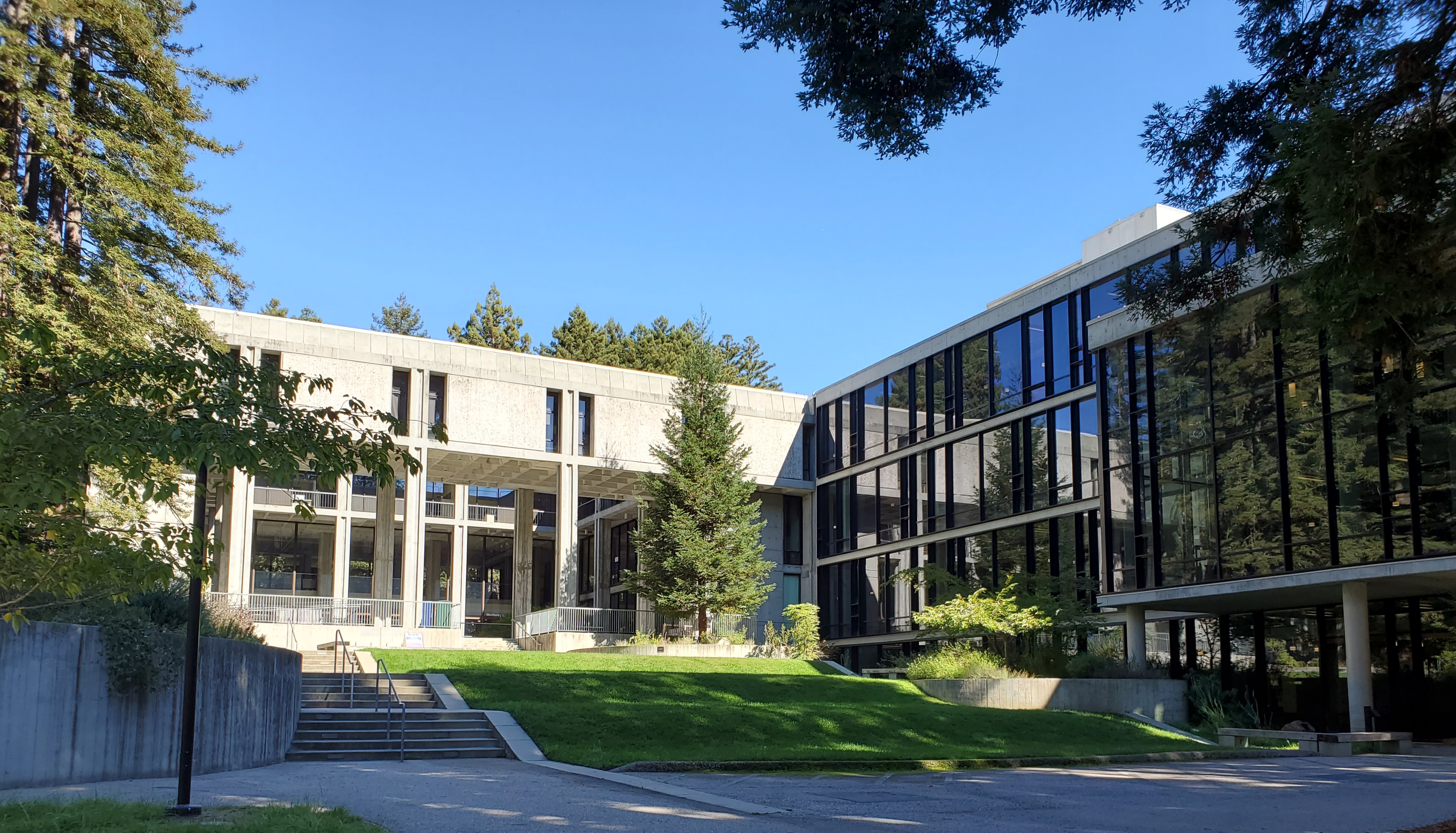
McHenry Administrative Suite dedicated in memory of alumnus Gabe Zimmerman
An Interview with Irene Reti, Director of the Regional History Project
How a passionate donor can help amplify what we do at the University Library
The David Rigler Photography Endowment
Special Collections & Archives staff support faculty and students during COVID-19 shutdown
10,000 images of Historic Santa Cruz County Now Online
Dear friends of the Library,
It has been six months since I last wrote to you, but it feels like a lifetime. The University Library has weathered these challenging times as it has so many before them: by listening to the needs of our patrons, relying on the generosity of our donors, and focusing on our core mission that has guided us for nearly sixty years.
An alumnus who exemplified that core mission was Gabe Zimmerman, who was killed when former Representative Gabrielle Giffords was shot on January 8, 2011. In February of this year, we held a ceremony to rededicate the fourth floor administrative suite of the library in his name. Both of his parents as well as many of his friends from UCSC (including our newsletter author, Zoe Quinton) and beyond gathered in his memory, a moving acknowledgment that made his loss more intense, but also highlighted how important it is to have his legacy live on. Both of Gabe’s parents stated that UCSC made Gabe who he was, which was a crucial lesson to keep at heart as we entered into the pandemic and our sudden campus closure.
Now that it is fall, it is time for us to start looking forward once more, to take stock of the current situation and examine the longer-term impact of the pandemic. What better place to start than to do a deep dive into the history of our campus, as presented so beautifully by the Regional History Project and its recent two-volume oral and visual history of the campus, Seeds of Something Different? This issue of the newsletter features an interview with Irene Reti, head of the Regional History Project and co-editor of Seeds, about the Project itself and the work they did on this book as well as future oral history collections.
We also spoke with Professor Emeritus Michael Cowan, two-time head of the Academic Senate, former Merrill provost, and founding chair of the American Studies Department. In his interview, Professor Cowan presents the case for funding a full-time University Archivist position. He sees an Archivist as someone who would not only create a comprehensive history of the campus through its written archives but also act as an ambassador to the community, actively gathering information to supplement the materials we already have while also raising awareness about our history. Professor Cowan is a great example of how a single passionate donor can help amplify what we do here at the library, whether that passion is specific, as with the Archivist position, or more general.
Donations to the library can also be used to honor the memory of a special person while helping pave the way for future generations of scholars and artists. Such is the case with the David Rigler Photography Endowment, established by Marilyn Rigler, along with David and Marilyn's children: Sara, Joel, and Mark. David Rigler carried a love of photography with him throughout his long and fascinating life, so it was a fitting tribute to him for his family to honor his memory by helping our Head of Special Collections & Archives maintain and acquire new photographic collections.
And finally, the generosity of our donors has been crucial in helping us make a successful pivot to supporting fully remote instruction. At the start of the campus closure, Randy Wedding, UC Santa Cruz Foundation Trustee, repurposed his existing endowment to help support the RISE Fund, which supports expanded instructional design capabilities and provides resources to enhance the online and remote teaching and learning experience. In particular, the RISE Fund has helped us license essential new digital content, especially streaming media, which tends to be expensive and is in very high demand. By making access to this information readily available, donors like Randy Wedding are helping us transition to a more robust, fully-digitized learning environment.
As we loo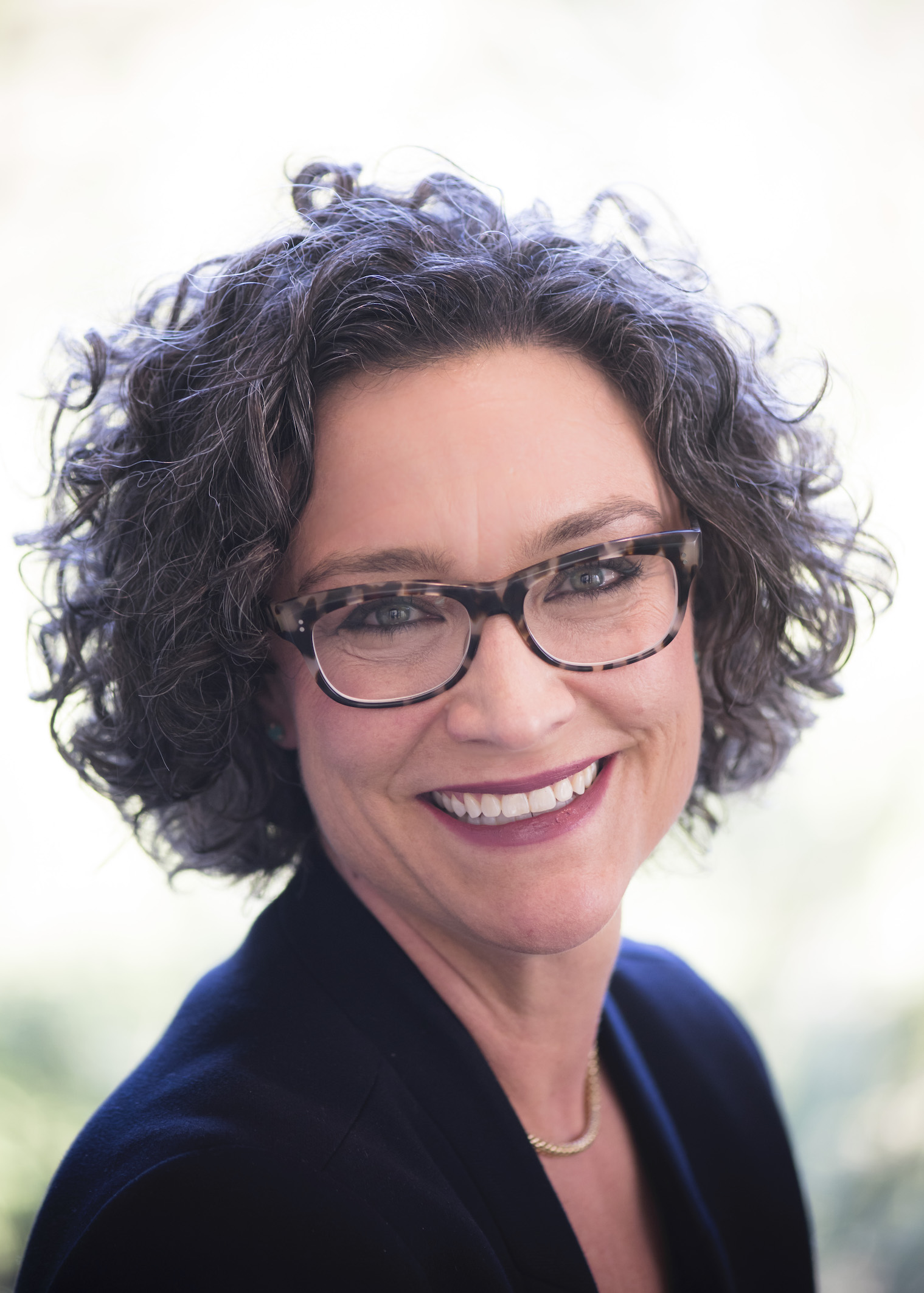 k to the future of our campus and our community, there is no doubt that things will be different in the months and years to come. With the ongoing economic and social disruption occurring both at the University and the country at large, we need our donors and friends even more than ever before to help us continue to make these crucial transitions as smooth as possible. We can and will continue to keep our campus’s legacy alive as we move into the uncertainty of the 21st century, but we cannot do it alone.
k to the future of our campus and our community, there is no doubt that things will be different in the months and years to come. With the ongoing economic and social disruption occurring both at the University and the country at large, we need our donors and friends even more than ever before to help us continue to make these crucial transitions as smooth as possible. We can and will continue to keep our campus’s legacy alive as we move into the uncertainty of the 21st century, but we cannot do it alone.
Be well, and stay safe,
Elizabeth Cowell
Richard L. Press University Librarian
Presidential Chair
McHenry Administrative Suite dedicated in memory of alumnus Gabe Zimmerman
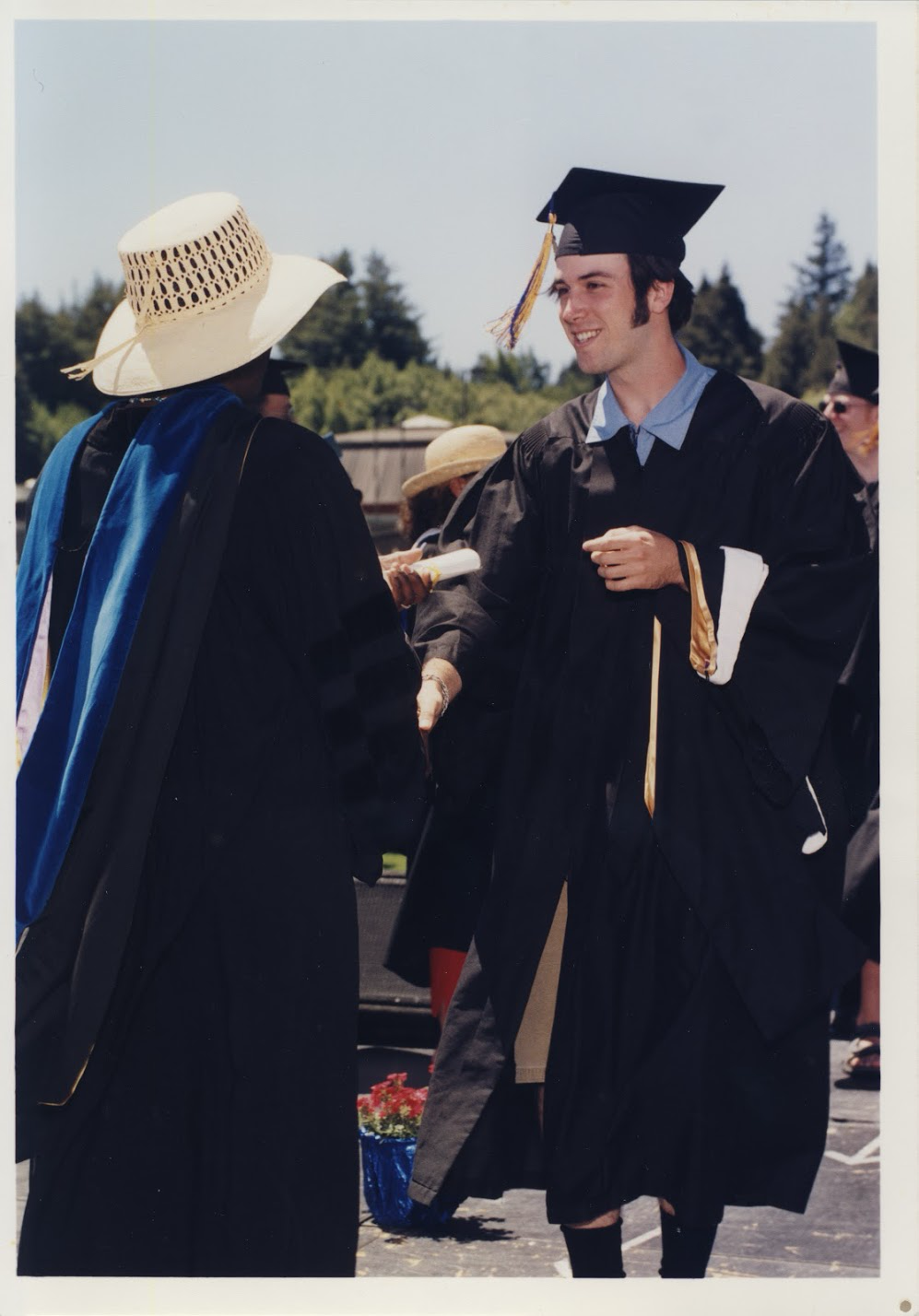 I first met Gabe Zimmerman in our first year at UCSC. We were both living in House Two at Stevenson College on the second floor. We soon had a big group of friends in common, and I spent a lot of time with him throughout college.
I first met Gabe Zimmerman in our first year at UCSC. We were both living in House Two at Stevenson College on the second floor. We soon had a big group of friends in common, and I spent a lot of time with him throughout college.
Gabe had one of those smiles that always made you feel a little better about the world, and he dispersed it as liberally as he did his hugs. Always wearing a baseball hat and baggy jeans, that sweet guy I knew in college soon went on to lend that same smile to his Congresswoman’s constituents back home in Arizona. He was Gabrielle Gifford’s chief of staff, and as I found out at the dedication for the McHenry Library administrative suite named in his honor, he was often referred to as the “constituent whisperer.”
That was Gabe — always making the world a better place. I am confident that if he had not tragically been shot and killed, he would’ve been in office today himself. He had that kind of glow about him. You just knew that he was a born public servant, bound to make the world a better place.
That room dedication ceremony was all the way back in February, so pre-COVID-19, pre-lockdown, pre… well, 2020, really. Back in the time where you could safely sit in a room full of people without masks on, and hug your old college friends, and even occasionally take a full, deep breath without crippling anxiety setting in. Looking back on that day, the words Gabe’s loved ones spoke about him and the lessons we all learned from his life — and his tragic death — are possibly even more relevant now than they were in that far away “normal” world.
 Gabe’s memory, as represented in that beautiful airy suite up on the fourth floor of the library, is a reminder that we cannot be complacent — not when things are good, and most certainly not when things get hard. We owe it to Gabe and those like him to work for change —real, meaningful, lasting change. His legacy is a constant reminder that we must try to respond to tragedy not by giving up or backing down, but by becoming an even stronger force for good.
Gabe’s memory, as represented in that beautiful airy suite up on the fourth floor of the library, is a reminder that we cannot be complacent — not when things are good, and most certainly not when things get hard. We owe it to Gabe and those like him to work for change —real, meaningful, lasting change. His legacy is a constant reminder that we must try to respond to tragedy not by giving up or backing down, but by becoming an even stronger force for good.
As Gabe’s mom said to us that day, “I hope that this room will help others to make a difference in the world.” It will. We will. And I very much hope you join me in doing so.
Best,
Zoe Quinton
An Interview with Irene Reti, Director of the Regional History Project
Having trained as a historian myself, I was very excited to talk with Irene Reti, Director of the Regional History Project at the University Library and co-editor of this spring’s two-volume oral history of UC Santa Cruz entitled Seeds of Something Different. Edited along with Cameron Vanderscoff and Sarah Rabkin, Seeds encompasses 57 years of oral history, including interviews with over 200 people and pictures of the campus, both contemporary and historic.
 This ambitious project was conceived of as a means to tell a multi-layered, multi-vocal story of the University and to raise public awareness around the Regional History Project itself. Founded in 1963 by Dean McHenry and Donald Clark, the founding University Librarian, the Regional History Project has been documenting the history of the Central Coast of California and the institutional history of UC Santa Cruz ever since.
This ambitious project was conceived of as a means to tell a multi-layered, multi-vocal story of the University and to raise public awareness around the Regional History Project itself. Founded in 1963 by Dean McHenry and Donald Clark, the founding University Librarian, the Regional History Project has been documenting the history of the Central Coast of California and the institutional history of UC Santa Cruz ever since.
The program has accrued a huge amount of archival content during that time, but accessibility has been a problem. For many years, you had to prove you were a researcher to access the archives. Even once that barrier was removed, the public was either unwilling to overcome the practical inconveniences of accessing it in person (such as limited parking and restricted hours) or simply overwhelmed by the sheer volume of information available digitally. She says: “we needed to portray the story in a different way.”
Irene, Cameron, and Sarah (all of whom have professional backgrounds in writing) collaborated to create a history of the campus that follows a compelling, cohesive narrative. They also succeeded in allowing for multiple accounts of the campus’s past, revealing a story that goes far deeper than the traditional romanticized accounts of UCSC’s early history. By doing so, they followed the thread of the founders’ original vision — what Irene refers to as the “grand experiment” at the core of UCSC’s inception —all the way through its six decades to the current era.
In the end, Irene says, the experiment that was UCSC has been a success, as that same adventurous, interdisciplinary “cowgirl mentality” has gone on to form the underpinnings of a lot of amazing activism and scholarship. In fact, Irene says that the current reality of UCSC is in some ways even more true to its original ethos than ever before. Originally conceived of as the City on a Hill, UCSC was founded upon a certain removal from the world from which we could better study it. Now, however, it has become more of a “democracy in action,” according to Irene.
Seeds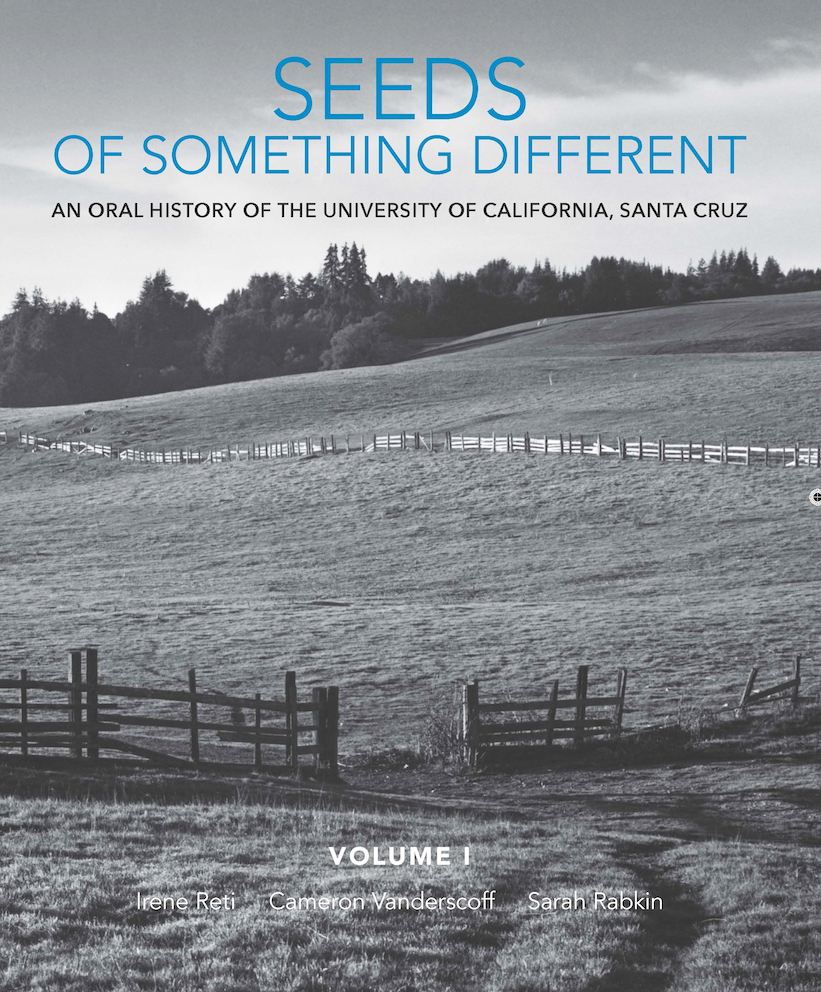 was published in the spring of 2020, and while its in-person launch event had to be canceled due to COVID-19, the Library was able to transition its planned set of lectures into an online summer event series comprised of six discussions between the three editors, founding members of the campus faculty, and current students. As a pleasant surprise, the virtual nature of the series meant that people from all over the country and beyond were able to attend, creating far more engagement with alumni and other supporters of the University than would have otherwise been possible.
was published in the spring of 2020, and while its in-person launch event had to be canceled due to COVID-19, the Library was able to transition its planned set of lectures into an online summer event series comprised of six discussions between the three editors, founding members of the campus faculty, and current students. As a pleasant surprise, the virtual nature of the series meant that people from all over the country and beyond were able to attend, creating far more engagement with alumni and other supporters of the University than would have otherwise been possible.
In fact, the first print run of 300 copies was so successful that it sold out almost immediately, and the Project would not have had any money to do a reprint until the next fiscal year started three months later. Thanks to a generous donation by alumni Mark Headley (Stevenson ‘83) and his wife Christina Pehl, however, they were able to do a second print run in time to keep up with the continued demand generated by the lectures.
When I asked Irene what she was doing after completing a project of such magnitude, she told me that with a grant from the Counseling Center, the Project is now doing an oral history of the impact of COVID-19 on campus. The recent fires that nearly reached campus as well as the overall political and social climate of 2020 will provide a backdrop to the story, which will be published by June 2021. That same month will see the completion of a digital archive of the oral history of Chancellor Blumenthal’s tenure at UCSC, which at over 2000 pages will be the biggest project they’ve ever done in the history of the program.
If you are interested in finding out more about Seeds, including how to purchase it at either Bookshop Santa Cruz or the Bay Tree Bookstore and have it shipped to you, please see the project’s webpage, here.
How a passionate donor can help amplify what we do here at the library
During Professor Michael Cowan’s four decades at UC Santa Cruz, he held many important roles: founding chair of the America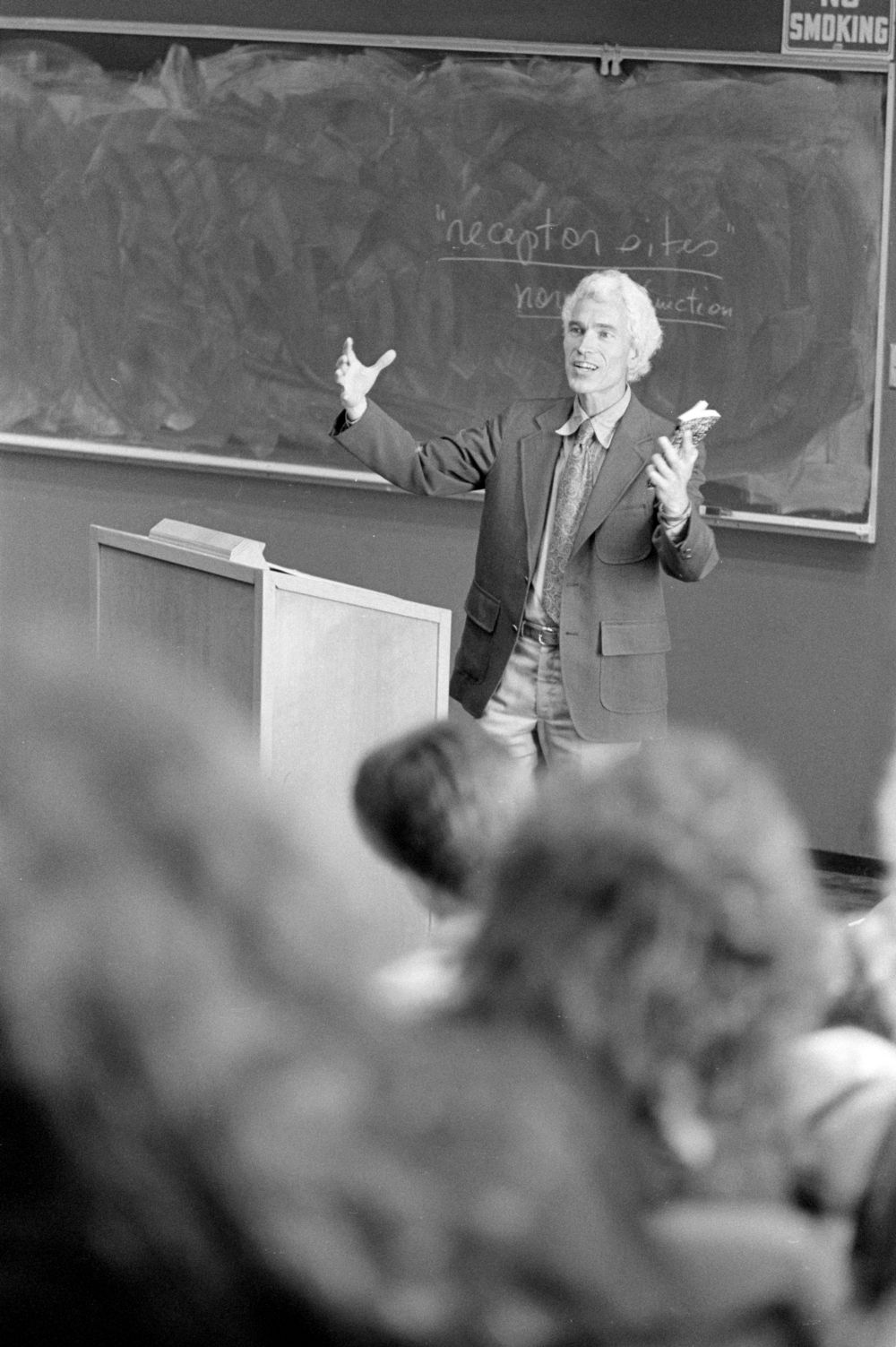 n Studies Department, former Provost of Merrill College, dean of the Division of Humanities, and twice chair of the Santa Cruz Division of the Academic Senate — first in 1979 to 1980 and again from 1994 to 1996.
n Studies Department, former Provost of Merrill College, dean of the Division of Humanities, and twice chair of the Santa Cruz Division of the Academic Senate — first in 1979 to 1980 and again from 1994 to 1996.
Given this front-seat role in the history of UC Santa Cruz, it is little wonder that Professor Cowan is an enthusiastic supporter of creating a permanent, full-time University Archivist position. Teresa Mora, the Head of Special Collections & Archives, is currently the acting University Archivist after previously holding the position full-time for two years. Prior to her appointment, there had never been an official Archivist position since the founding of the campus. Of our UC peers, only UC Merced lacks such a position.
Teresa’s efforts as acting Archivist have been supplemented by the work of the Regional History Project, including Seeds of Something Different, the two-volume oral history of the campus published this spring (and featured in this edition of the newsletter.) Michael says that while Irene has been doing an amazing job of using her and her colleagues' many interviews as well as photographic evidence to help fill in many gaps of the official University records —for example, by including important accounts from women and ethnic minority informants as well as from the arts and environmental studies departments — oral histories offer only a partial record and would greatly benefit from written archives that go well beyond those generated by the campus's major administrative units.
Special Collections & Archives holds nearly sixty years of documents for a future Archivist to organize and process. But there are likely still major gaps in that collection. Michael said that while the record can never be exhaustive, we should aim for it to be as complete as possible. The Archivist must be able to think like a historian and develop a program for acquiring missing materials, which requires that they be actively engaged in outreach for the Library, going out into the community and seeking out various sources to fill in the gaps in the record.
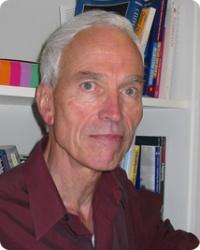 Michael described the Archivist as the “head of an intellectual recycling center,” someone who takes things that would otherwise have been discarded as junk and turns them into a new product, one with ongoing value that can be used over and over again. Even if the documents themselves aren’t used for years, he says, they should be collected now and stored in a strategic, streamlined way for future scholars to access.
Michael described the Archivist as the “head of an intellectual recycling center,” someone who takes things that would otherwise have been discarded as junk and turns them into a new product, one with ongoing value that can be used over and over again. Even if the documents themselves aren’t used for years, he says, they should be collected now and stored in a strategic, streamlined way for future scholars to access.
In Michael’s vision, our CART (Center for Archival Research and Training) program could act as a vital part of this recycling process, with graduate students sorting and using these primary documents as part of a case study, all under the supervision of the University Archivist. This would give the students vital experience working with archival material while also helping the Archivist sort through the backlog of information.
For now, a full-time Archivist position remains out of reach given the University’s financial situation. However, gathering and organizing a more complete written record of UCSC’s history by someone who has the highly specialized skill to do so, seems critical according to Michael. And ultimately, as the publication of Seeds has shown, creating a more accessible, cohesive account of our campus has direct benefits for the entire campus, generating greater interest and awareness around our history. When the University Archivist position hopefully, eventually, is funded, Michael strongly believes that it will quickly become an integral part of our campus’s legacy and its path to future success.
The David Rigler Photography Endowment
At the end of last year, the David Rigler Photography Endowment was established by Marilyn Rigler, along with David and Marilyn's children Sara, Joel, and Mark, to honor David’s memory and his lifelong love of photography. The proceeds support the Head of Special Collections & Archives in preserving, organizing, and making the University Library’s photographic collections discoverable and accessible to the faculty and students of UCSC, as well as the general public. It also supports the broader needs of the photographic collection, including the acquisition of new works.
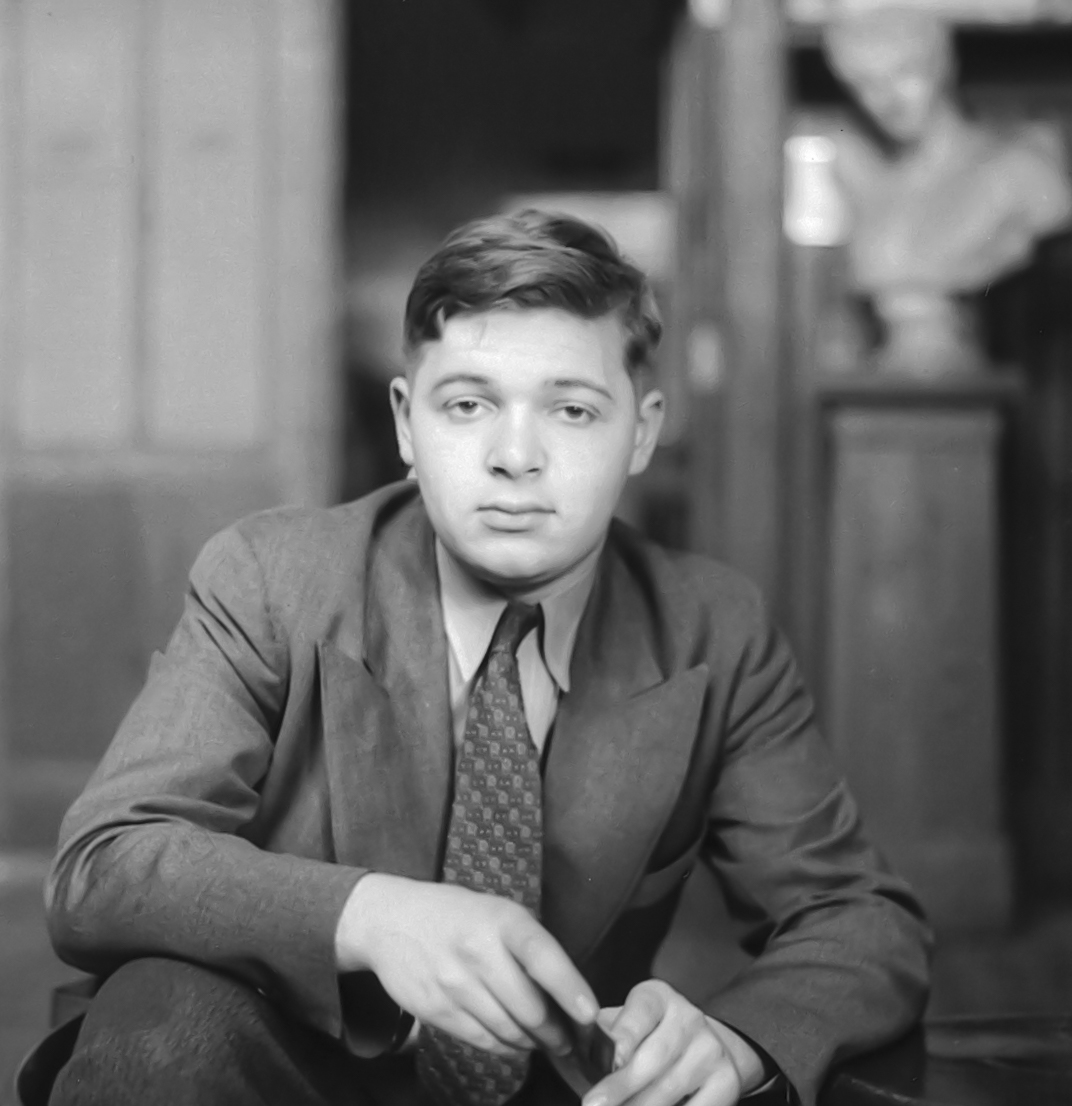 David Rigler fell in love with photography at the age of thirteen, when he was given a Kodak Brownie box camera. As a young adult, he joined the Camera Club of New York, which was later to become highly influential in the field. Later in life, David’s passion grew to encompass video, video editing, digital SLR, and Photoshop. His son Joel says that he “never saw him without a camera in his hand,” so this endowment opportunity felt like it “fit really well.”
David Rigler fell in love with photography at the age of thirteen, when he was given a Kodak Brownie box camera. As a young adult, he joined the Camera Club of New York, which was later to become highly influential in the field. Later in life, David’s passion grew to encompass video, video editing, digital SLR, and Photoshop. His son Joel says that he “never saw him without a camera in his hand,” so this endowment opportunity felt like it “fit really well.”
Beyond his passion for photography Joel describes David as having been a true Renaissance Man. As a child, he was an inconsistent student, brilliant where he wanted to be and skipping classes he had no interest in. Joel remembers going together to a jazz concert at Cabrillo when David was in his 90s. When they played a Benny Goodman tune, David told his son about the time when he was in high school and cut class to sneak in and see Goodman perform live.
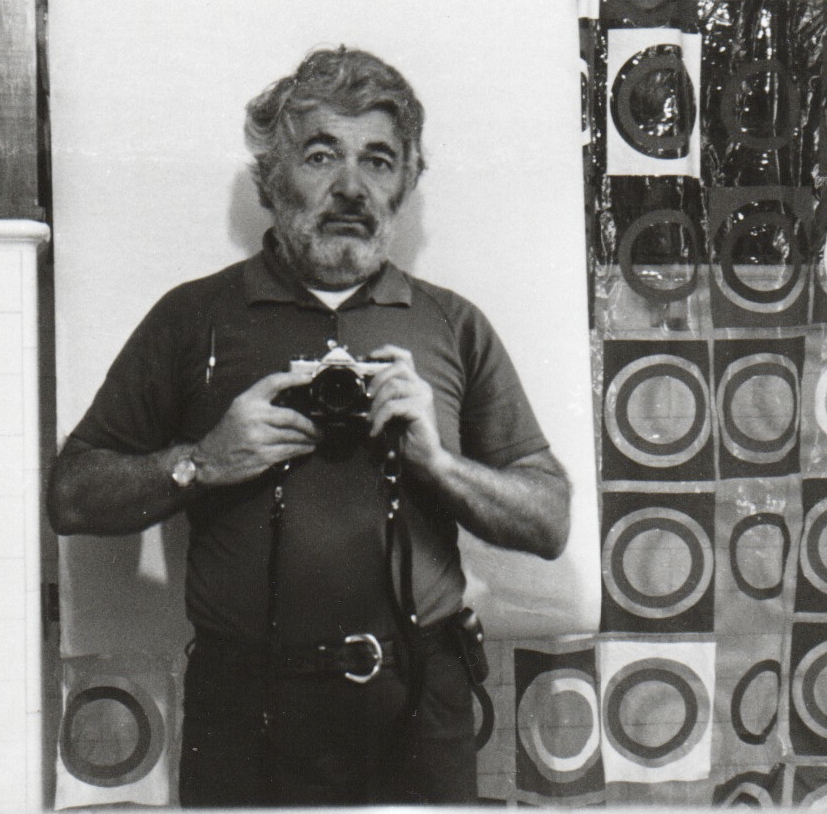 David was also an early techie, forever taking machines apart and, as Joel says, sometimes putting them back together. He was self-taught in electronics, and so loved chemistry that he succeeded in blowing up the high school chemistry lab at least once or twice. His mother, afraid that Jews wouldn’t be hired in technical or scientific jobs during the pre-World War II era, discouraged him from pursuing either field as a career. Instead he did a short stint at City College before leaving school and his parents’ apartment to put his passion for science to work as a civilian for the Department of War in New Jersey, where he worked on a top secret program that created the technology that soon became known as radar. He was later sent to Panama to do radar installations, where he learned Spanish, explored areas of Guatemala and El Salvador, and took many photos of the local residents.
David was also an early techie, forever taking machines apart and, as Joel says, sometimes putting them back together. He was self-taught in electronics, and so loved chemistry that he succeeded in blowing up the high school chemistry lab at least once or twice. His mother, afraid that Jews wouldn’t be hired in technical or scientific jobs during the pre-World War II era, discouraged him from pursuing either field as a career. Instead he did a short stint at City College before leaving school and his parents’ apartment to put his passion for science to work as a civilian for the Department of War in New Jersey, where he worked on a top secret program that created the technology that soon became known as radar. He was later sent to Panama to do radar installations, where he learned Spanish, explored areas of Guatemala and El Salvador, and took many photos of the local residents.
Returning to the States to attend college on the GI Bill, David graduated Phi Beta Kappa from Ohio University and received his PhD in Psychology from the University of Michigan. While at Ohio University, David met his lifelong love, Marilyn, and they were married in 1948.
David’s ensuing career as a child psychologist included a 7-year stint developing multi-year life studies at the University of Colorado in Denver, 3 years doing grant review at the National Institute of Mental Health in Bethesda, and 14 years as Chief Pediatric Psychologist at Children's Hospital in Los Angeles with an appointment as Professor of Psychology at USC. When asked what school of psychology he belonged to — a crucial question at a time when almost all psychologists ascribed to one school or another — David would simply say, “I talk to people.”
Starting in the early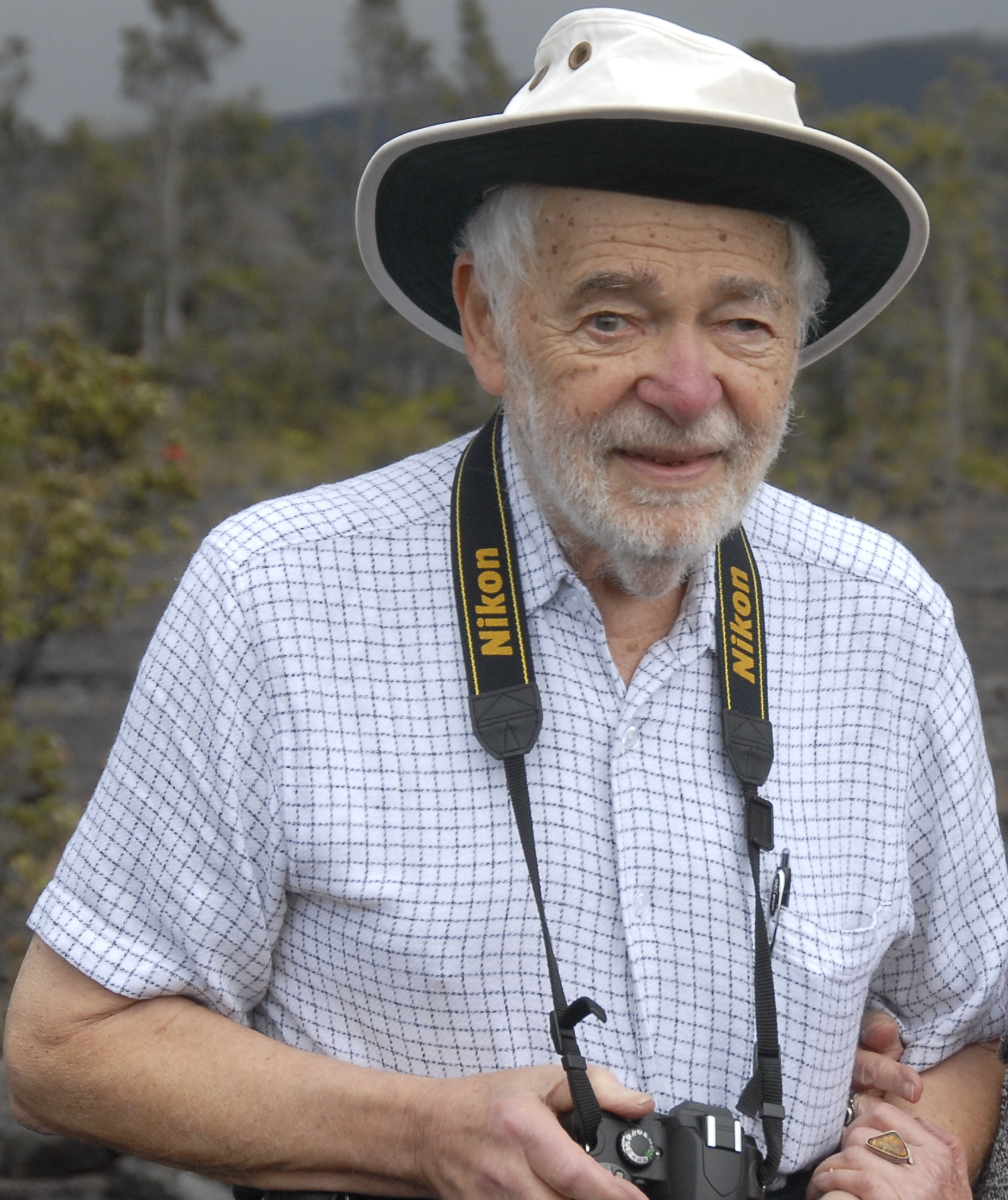 1980s, the entire family converged on Santa Cruz. Joel got into UCSC after high school, but his brother Mark transferred to UCSC from Reed College and arrived here before Joel did. Their parents followed in 1983, followed by their daughter, Sara, a few years later. Joel says that within a week of moving here, his parents knew more people in Santa Cruz than he did.
1980s, the entire family converged on Santa Cruz. Joel got into UCSC after high school, but his brother Mark transferred to UCSC from Reed College and arrived here before Joel did. Their parents followed in 1983, followed by their daughter, Sara, a few years later. Joel says that within a week of moving here, his parents knew more people in Santa Cruz than he did.
David worked with an architect to design and then build their house on the Westside of Santa Cruz. The family still has pictures of David supervising and participating in the construction at the age of 62, building the home he loved. David and Marilyn lived in that house for the rest of his life.
Marilyn and all three of her kids still live in Santa Cruz. Joel, his wife Celsa, and Marilyn now live in the same house his father built. David passed away in 2014, which would have been his and Marilyn’s 65th wedding anniversary.
By establishing the David Rigler Photography Endowment, their donation both keeps David’s memory alive while helping future generations of techies, innovators, and avid photographers to learn and thrive.
Donor Randy Wedding shares about the RISE Fund and how it aims to allow UCSC to turn a crisis into an opportunity
In his champi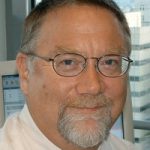 onship of the RISE (Recover, Innovate, Support, Educate) Fund,
onship of the RISE (Recover, Innovate, Support, Educate) Fund,
Randy Wedding, Trustee of the UC Santa Cruz Foundation Board, has been actively fundraising to support the campus transition to distance learning — both as an immediate response to the COVID-19 pandemic and as a longer-term bridge to increased academic resilience and flexibility. The RISE Fund, managed by the Campus Provost/Executive Vice Chancellor, supports expanded instructional design capabilities and provides resources to enhance the online and remote teaching and learning experience.
While online learning will never replace the richness of in-person classroom teaching, the RISE Fund aims to allow UCSC to turn a crisis into an opportunity. By reimagining current pedagogical practices, distance learning will allow us to emerge from the campus shutdown even stronger than before. In other words, as the RISE statement of purpose says, the resources adopted as a response to the pandemic will help “position UCSC as a campus that dares to teach and learn differently,” thereby fulfilling the ongoing legacy of its founding educators.
Randy Wedding has been a part of the UC system for most of his life, and calls it “the best public university system in the world.” He graduated from UC San Diego, his father taught at Riverside, and his sister went to UC Berkeley. Randy worked as Senior Managing Director of Fixed Income at the UC Regents as well as teaching at the Haas School of Business at UC Berkeley for several years. Even in retirement, he remains a Trustee of the UC Santa Cruz Foundation.
Eight years ago, Randy and his wife Celia started an endowment at the University Library in the memory of their late daughter, an alumna of UCSC. The endowment was originally dedicated to literature and journals related to Oceania, and in particular funded the research of Professor Stacy L. Kamehiro, who studies colonial Hawaiian visual and material culture.
When the pandemic hit, Randy says, UCSC and the rest of the UC campuses were faced with an “existential crisis” a long time in the making. Despite its excellence, Randy says the UC system has been “under a lot of long-term stress” due to deterioration in state support and associated rising tuition costs. COVID-19 exacerbated the budget shortfalls by simultaneously reducing revenue and creating unforeseen expenses. As a result, getting a University of California education has become less affordable and less accessible in multiple ways — many of which could, and perhaps should have been addressed by exploring remote teaching long before now. COVID-19 is acting as a major catalyst in that direction, and will push us to address many of these long-standing issues that the pandemic has brought to the forefront.
To that end, when the Chancellor created the RISE Fund, she also presented donors with a list of immediate needs to help jumpstart the University in its transition to remote learning. These needs were categorized into four areas: testing, research, Slug support (i.e. student aid), and remote teaching. The latter category includes work being done by the Library, the Center for Innovations in Teaching and Learning (CITL), and Online Education (OE). Randy decided to transition his daughter’s endowment into current funding: half would now go directly to the RISE Fund to support the Library/CITL-OE, and the other half to Professor Kamehiro, who will use it as she takes on the editing and production of the existing Pacific Arts Journal.
The RISE Fund has helped the Library and CITL-OE to support students and faculty as they made the unexpected transition to fully remote learning. The Library’s top priorities are content and access-related — making sure that students and faculty have access to the online resources they need to support their classes. The CITL-OE team, in collaboration with Information Technology staff, is focused on providing effective distance learning technology and pedagogy to enhance education. This includes training faculty in best practices, helping them redesign their courses for remote teaching, and providing what OE calls “Home Studio Kits.” These kits contain a high-quality USB microphone, ring lighting, and, for those who need them, a 4K webcam or a tablet. By addressing the accessibility and affordability issues Randy detailed above, these adaptations and others will be crucial not only for the duration of the pandemic but for a long time to come.
As important as the technological tools have been for many instructors, the less visible impact of Randy’s gift was even more consequential. As Associate Vice Provost and CITL Director Jody Greene put it, “thanks to Randy’s generosity, we were able to hire extra consultants to work with faculty throughout the Summer, using research-based methods to redesign their courses to be ready for Fall 2020. Thanks to Randy’s gift, we not only got the tools our instructors need, but we were able to support them to make the best use of those tools for the benefit of our students.”
In closing, Randy pointed out that one of the things that surprised him most when he became a Trustee was the low level of philanthropy among UCSC alumni. Private universities have always relied on their graduates to give back and support current initiatives, and despite our publicly-funded origins, the UC system now needs to learn how to do the same. This is an “all-hands-on-deck problem,” Randy says, and COVID-19 has only made it worse. Now is the best possible time to consider supporting the University, both to help it weather the current crisis and to anticipate the learning and accessibility needs of future generations of students.
Special Collections & Archives staff support faculty and students during COVID-19 shutdown
Despite the limitations presented by sheltering in place, Special Collections & Archives continues to fulfill its mission to engage students in using our collections and thinking critically about issues of memory and history. Our fifth annual collaboration with Porter College’s Core class will look different this fall, as we “host" 450 first-year Porter students in virtual visits to explore our collections. Outreach & Exhibits Librarian Jessica Pigza will visit each class section via Zoom, and has developed a website to introduce the students to artists’ books.
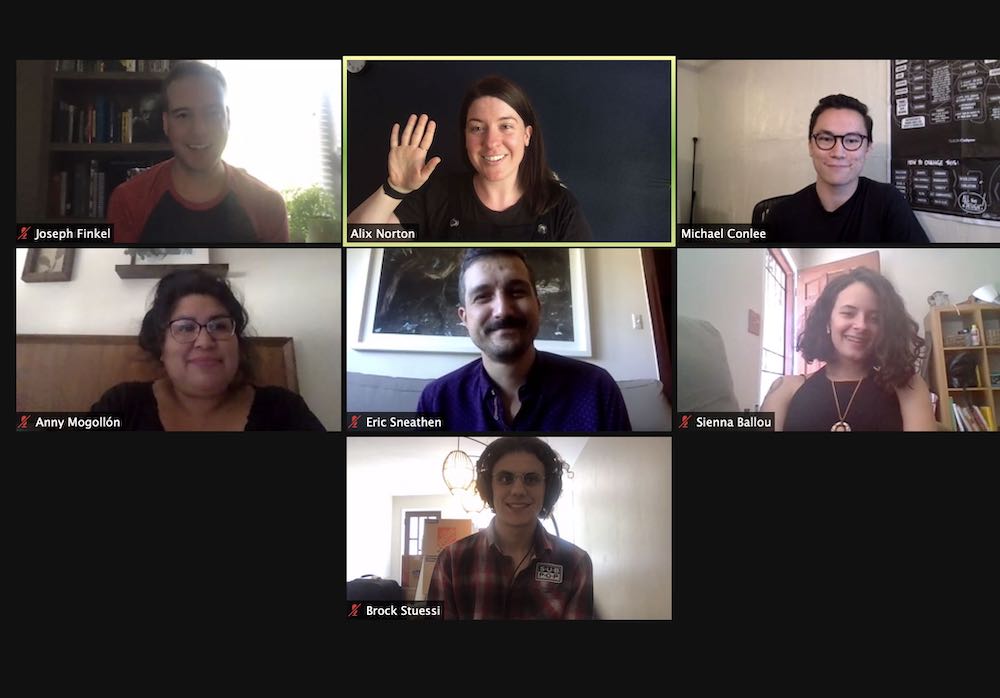 The Center for Archival Research and Training (CART) continues, albeit remotely, with a cohort of five new fellows for the 2020/21 academic year. CART Archivist Alix Norton dedicated much of her summer to reimagining the CART program to ensure each fellow has a meaningful experience delving into issues surrounding the theory and practice of archives, all in a completely remote environment. We’ve continued our “out of the box” thinking and re-envisioning of our work by conceiving of new projects as well. Regional History Project Director Irene Reti developed a project to train a cohort of five UC Santa Cruz students (four undergraduates and one graduate student) in oral history. The students will work throughout the coming year to interview members of the UCSC community about their experiences during the pandemic. Additionally, in partnership with our colleagues in Digital Initiatives, we continue to publish new content to our digital collections site to enable remote use of primary source materials. As discussed elsewhere in the newsletter, we've just published over 10,000 historical photographs of Santa Cruz County. We also just published recordings of over 50 years of Cabrillo Music Festival performances. These newly digitized materials are immediately accessible for faculty use as well as student exercises and projects.
The Center for Archival Research and Training (CART) continues, albeit remotely, with a cohort of five new fellows for the 2020/21 academic year. CART Archivist Alix Norton dedicated much of her summer to reimagining the CART program to ensure each fellow has a meaningful experience delving into issues surrounding the theory and practice of archives, all in a completely remote environment. We’ve continued our “out of the box” thinking and re-envisioning of our work by conceiving of new projects as well. Regional History Project Director Irene Reti developed a project to train a cohort of five UC Santa Cruz students (four undergraduates and one graduate student) in oral history. The students will work throughout the coming year to interview members of the UCSC community about their experiences during the pandemic. Additionally, in partnership with our colleagues in Digital Initiatives, we continue to publish new content to our digital collections site to enable remote use of primary source materials. As discussed elsewhere in the newsletter, we've just published over 10,000 historical photographs of Santa Cruz County. We also just published recordings of over 50 years of Cabrillo Music Festival performances. These newly digitized materials are immediately accessible for faculty use as well as student exercises and projects.
10,000 images of Historic Santa Cruz County Now Online
 From Watsonville apples to ZaSu Pitts, the University Library’s Santa Cruz County Historic Photograph Collection has something for everyone. Its 10,000 photographs, taken between 1866 and 1995, offer glimpses of the region’s past: industries, homes, parades, schools, street and waterfront scenes, disasters, schools, and quite a few once-famous actors participating in the region’s early 20th-century film industry. And as of October 1st, visitors to the Library’s Digital Collections can now browse and explore the entirety of this significant collection from the comfort of their own homes.
From Watsonville apples to ZaSu Pitts, the University Library’s Santa Cruz County Historic Photograph Collection has something for everyone. Its 10,000 photographs, taken between 1866 and 1995, offer glimpses of the region’s past: industries, homes, parades, schools, street and waterfront scenes, disasters, schools, and quite a few once-famous actors participating in the region’s early 20th-century film industry. And as of October 1st, visitors to the Library’s Digital Collections can now browse and explore the entirety of this significant collection from the comfort of their own homes.
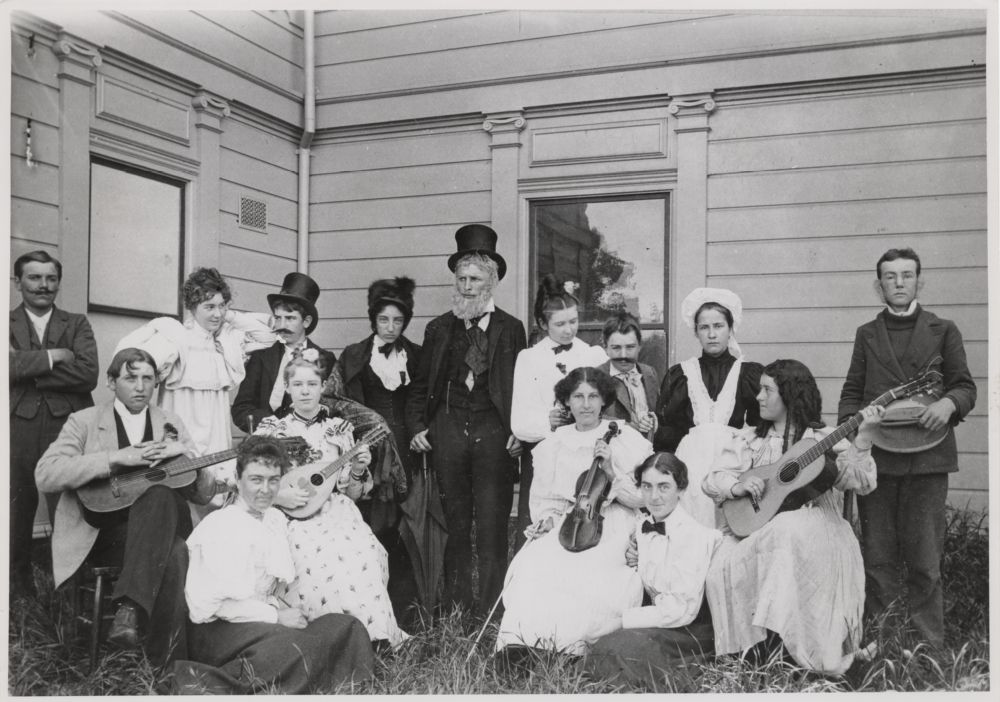 The Library is proud to be able to provide broad remote access to this collection, especially at this moment in time as we witness a dramatic digital turn in research habits and learning methods. The Santa Cruz County Historic Photograph Collection has always been of great interest for students as well as visiting researchers who would pore over the boxes of printed photographs (the collection fills 154 boxes) in the Special Collections & Archives Reading Room in search of details of history, genealogy, vernacular photography, and film history. Teresa Mora, Head of Special Collections & Archives, describes the collection as “a boon to local historians, genealogists and amateur researchers, providing unique insights into various aspects of Santa Cruz history as well as a better and deeper understanding of how the Santa Cruz of today came to be.”
The Library is proud to be able to provide broad remote access to this collection, especially at this moment in time as we witness a dramatic digital turn in research habits and learning methods. The Santa Cruz County Historic Photograph Collection has always been of great interest for students as well as visiting researchers who would pore over the boxes of printed photographs (the collection fills 154 boxes) in the Special Collections & Archives Reading Room in search of details of history, genealogy, vernacular photography, and film history. Teresa Mora, Head of Special Collections & Archives, describes the collection as “a boon to local historians, genealogists and amateur researchers, providing unique insights into various aspects of Santa Cruz history as well as a better and deeper understanding of how the Santa Cruz of today came to be.”
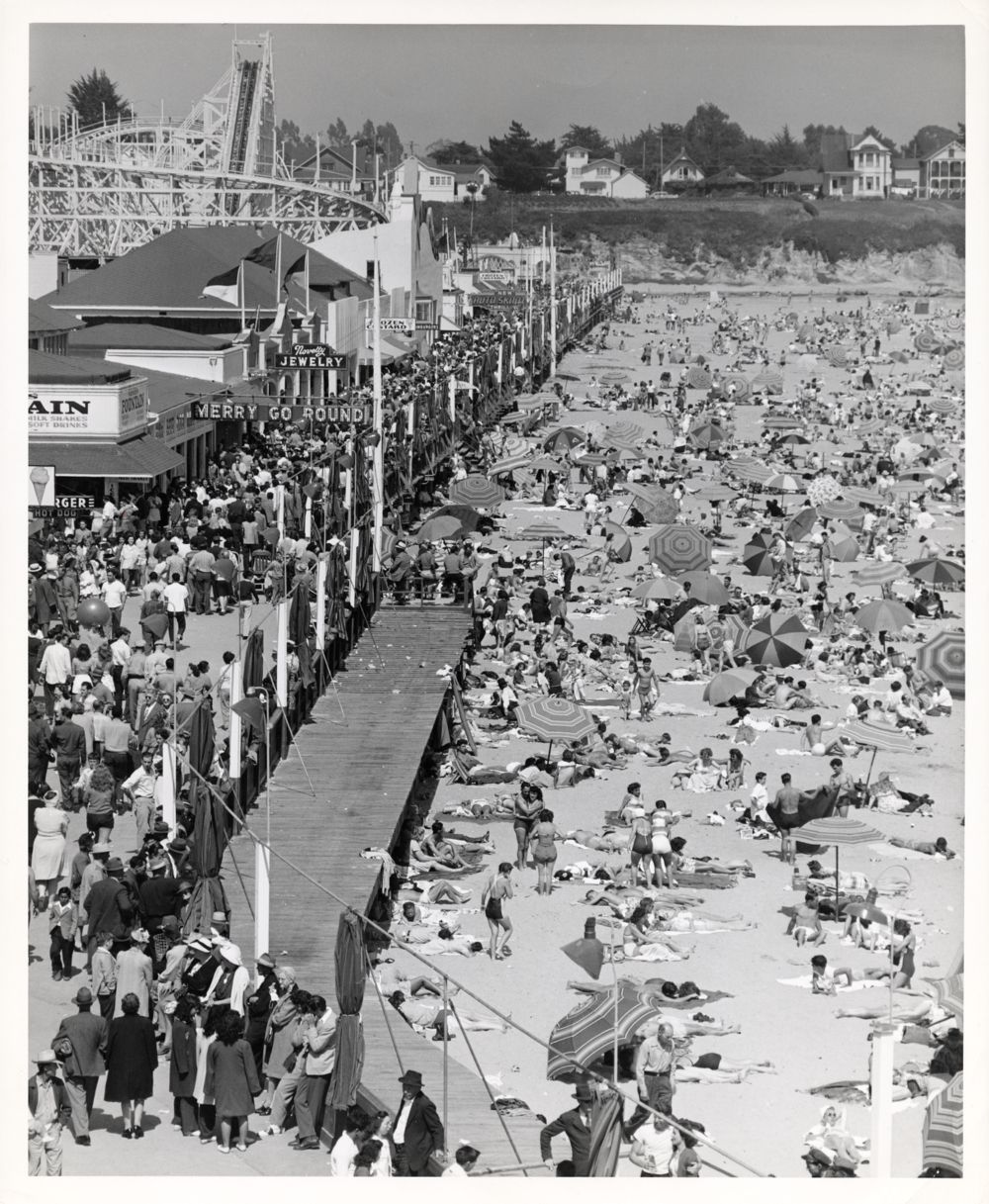 As this collection now takes its star turn online, thanks to efforts of the Library’s Digital Initiatives Department, we would like to celebrate the successive efforts that preserved and prepared this collection for use, since its acquisition by the Library in 1968. Preston Sawyer, a local journalist, photographer, and documentarian of Santa Cruz history, built the collection with photographs of his own as well as those taken by others. After his death in 1968, local historians and relatives of Sawyer continued his work to identify and supplement his collection with additional photographs from the community. Librarians and archivists at the University Library continued to build upon this foundation, preserving, organizing, and describing the images so that they could be discovered and used by researchers over the years. These combined efforts have culminated in the publication of the entire collection online, enabling the broadest possible audience the opportunity to explore this unique visual record of the history of Santa Cruz County.
As this collection now takes its star turn online, thanks to efforts of the Library’s Digital Initiatives Department, we would like to celebrate the successive efforts that preserved and prepared this collection for use, since its acquisition by the Library in 1968. Preston Sawyer, a local journalist, photographer, and documentarian of Santa Cruz history, built the collection with photographs of his own as well as those taken by others. After his death in 1968, local historians and relatives of Sawyer continued his work to identify and supplement his collection with additional photographs from the community. Librarians and archivists at the University Library continued to build upon this foundation, preserving, organizing, and describing the images so that they could be discovered and used by researchers over the years. These combined efforts have culminated in the publication of the entire collection online, enabling the broadest possible audience the opportunity to explore this unique visual record of the history of Santa Cruz County.
Explore the Collection
Read More about the Collection
Credits:
Contributors: Elizabeth Cowell, Zoe Quinton, Jessica Pigza, and Teresa Mora
Production: Linda Hunt
Copyediting: Greg Careaga
Photography: Linda Hunt, Alix Norton, Rigler Family, Andrea Lowgren, Zimmerman Family, and Carolyn Lagattuta
From UC Santa Cruz Special Collections and Archives:
UCSC Photo Collection
Michael Cowan, professor of American studies, in a classroom
Creator: Fukuda, Don
Santa Cruz County historic photograph collection
Zasu Pitts approximately 1919-1925
Santa Cruz High School - 1896
S.C. Beach & Boardwalk-Casino, 1950-1980


 Santa Cruz, CA
Santa Cruz, CA



